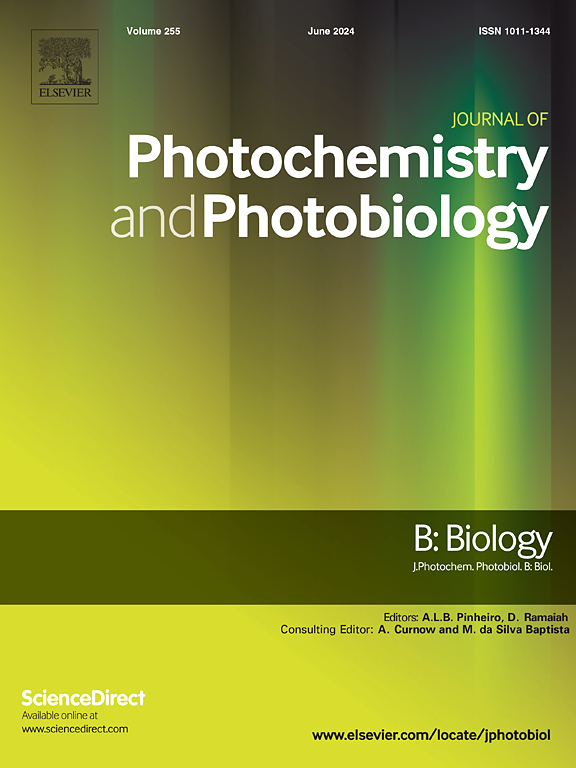Fluence-dependent infrared photobiomodulation remodels chromatin architecture to enhance chemosensitivity in head and neck tumors
IF 3.7
2区 生物学
Q2 BIOCHEMISTRY & MOLECULAR BIOLOGY
Journal of photochemistry and photobiology. B, Biology
Pub Date : 2025-06-29
DOI:10.1016/j.jphotobiol.2025.113208
引用次数: 0
Abstract
Photobiomodulation (PBM) therapy has emerged as a noninvasive therapeutic modality capable of modulating cellular processes through the targeted delivery of light. In this study, we investigated the effects of an infrared PBM on adenoid cystic carcinoma (ACC) cells, with a focus on fluence-dependent chromatin remodeling and the potential to enhance chemosensitivity to cisplatin. Using a range of energy densities, we observed that up to 26.6 J/cm2 of PBM induces significant nuclear enlargement and modulates epigenetic markers by increasing histone H4K8 acetylation and decreasing trimethylation of histone H3K9. These changes recapitulate the effects of histone deacetylase inhibitors, previously shown to sensitize tumor cells to chemotherapy. Notably, pre-treatment with a 20 J/cm2 fluence significantly enhanced cisplatin-induced cell death compared to sham controls, supporting the notion that an open chromatin state can potentiate chemotherapeutic efficacy. In contrast, higher fluences (≥ 33.3 J/cm2) led to a marked accumulation of DNA double-strand breaks and elevated reactive oxygen species, culminating in increased cell death. Additionally, while PBM consistently reduced cellular proliferation across fluences, it did not affect the migration potential of ACC cells. Owing to its high tissue penetrance, the infrared PBM presents a particularly novel and attractive approach for targeting deep-seated head and neck tumors, including those of salivary gland origin. Collectively, our findings suggest that lower-fluences of infrared PBM represents a safe and effective strategy to remodel tumor chromatin and enhance the chemosensitivity of head and neck cancers, paving the way for its integration into multimodal cancer treatment regimens.

影响依赖的红外光生物调节重塑染色质结构以增强头颈部肿瘤的化学敏感性
光生物调节(PBM)疗法已经成为一种非侵入性的治疗方式,能够通过靶向传递光来调节细胞过程。在这项研究中,我们研究了红外PBM对腺样囊性癌(ACC)细胞的影响,重点关注影响依赖性染色质重塑和增强顺铂化疗敏感性的潜力。在一定的能量密度范围内,我们观察到高达26.6 J/cm2的PBM诱导细胞核显著增大,并通过增加组蛋白H4K8乙酰化和降低组蛋白H3K9三甲基化来调节表观遗传标记。这些变化概括了组蛋白去乙酰化酶抑制剂的作用,先前显示组蛋白去乙酰化酶抑制剂使肿瘤细胞对化疗敏感。值得注意的是,与空白对照相比,20 J/cm2的预处理显著增强了顺铂诱导的细胞死亡,这支持了染色质开放状态可以增强化疗疗效的观点。相反,较高的影响(≥33.3 J/cm2)导致DNA双链断裂的显著积累和活性氧含量升高,最终导致细胞死亡增加。此外,虽然PBM在不同的影响下持续降低细胞增殖,但它不影响ACC细胞的迁移潜力。由于其高组织外显率,红外PBM提供了一种特别新颖和有吸引力的方法来靶向深部头颈部肿瘤,包括起源于唾液腺的肿瘤。总的来说,我们的研究结果表明,红外PBM的低影响是一种安全有效的策略,可以重塑肿瘤染色质并增强头颈部癌症的化疗敏感性,为其整合到多模式癌症治疗方案中铺平了道路。
本文章由计算机程序翻译,如有差异,请以英文原文为准。
求助全文
约1分钟内获得全文
求助全文
来源期刊
CiteScore
12.10
自引率
1.90%
发文量
161
审稿时长
37 days
期刊介绍:
The Journal of Photochemistry and Photobiology B: Biology provides a forum for the publication of papers relating to the various aspects of photobiology, as well as a means for communication in this multidisciplinary field.
The scope includes:
- Bioluminescence
- Chronobiology
- DNA repair
- Environmental photobiology
- Nanotechnology in photobiology
- Photocarcinogenesis
- Photochemistry of biomolecules
- Photodynamic therapy
- Photomedicine
- Photomorphogenesis
- Photomovement
- Photoreception
- Photosensitization
- Photosynthesis
- Phototechnology
- Spectroscopy of biological systems
- UV and visible radiation effects and vision.

 求助内容:
求助内容: 应助结果提醒方式:
应助结果提醒方式:


